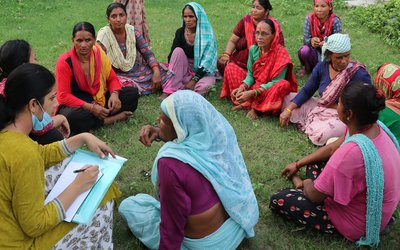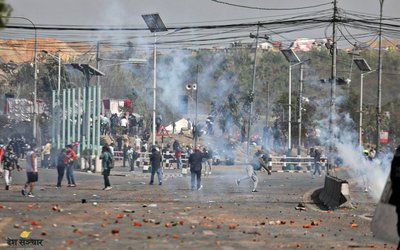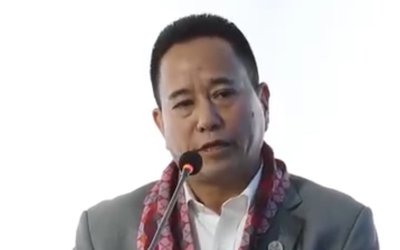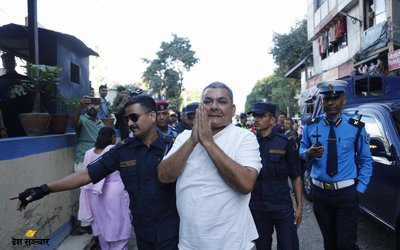
Foreword:
Recently on October 7, 2021 Kathmandu Post, Nepal’s daily newspaper, headlined ‘Nepal’s surplus energy is going to waste as there are no buyers yet’. According to Post, with the commissioning[1] of 456 MW Upper Tamakoshi, Nepal is spilling/wasting 200 to 600 MW of electricity daily. This power was touted to be traded in the Indian power exchange market. Yet the Post further quoted NEA’s Managing Director, Kulman Ghising, as saying that this wastage of electricity, in monetary terms, is around Rs 1.8 billion in the last one and half month and that next year another 300 to 400 MW of hydropower projects are expected to come on line. There are already under construction[2] 138 numbers of big/small hydropower projects totaling 3,507 MW that are expected to be commissioned shortly. NEA’s system Peak Load[3] on April 26, 2021 (Baisakh 13, 2078) was 1,482 MW. This would, hence, mean billions of Rupees worth of more energy wastage/spillage in the coming years. Why have we landed up in such an ‘energy wasting’ scenario when barely five years ago in 2016 we were suffering from around 18 hours of painful load shedding? This article attempts to discuss the genesis of our ‘surplus energy’ as well as that of ‘no buyers yet’.
Genesis of Surplus Energy:
i) Two Actors – Two Load Forecasts: To try to fathom out why we have landed in such a sad situation, it is, perhaps, necessary to relate a brief history of our power sector. The Ranas’ Bijuli Adda, since 1911, was unbundled in 1962 into the government’s Electricity Department (ED) and the semi-government Nepal Electricity Corporation (NEC). The Electricity Department planned and executed all generation, transmission and electrification projects required for the country. The Electricity Corporation, recipient of those projects after commissioning, operated them as a commercial entity. The mandate to prepare the national Load Forecast [4] fell on the shoulders of Electricity Department. Load forecast is a tool by which the country's overall power system master plan is prepared. Based on this forecast, the country's least cost generation expansion plan (LCGEP), transmission line expansion and even long-run marginal cost analysis are prepared. That is, decisions are made as to which generation projects (hydro/thermal based on Least Cost Generation Expansion Project, LCGEP) when and in what sequence. The execution of high voltage Transmission lines followed suit as required by the generation projects to be implemented. The Distribution system, similarly, was implemented as per the government’s electrification plan. As a commercial entity, Nepal Electricity Corporation also prepared its own load forecast. Thus, the two forecasts prepared by ED and NEC became the bone of contention. The Electricity Corporation, in its quest to be a responsible commercial organization answerable to its consumers, had the inherent urge to "push-up" (termed optimistic) the load forecast so that its operational deficiencies may not result in load shedding. On the other hand, the Electricity Department had that inherent urge to "pull-down" (termed pessimistic) the load forecast so that its inefficiencies in project implementation delays, hence load shedding, will be duly covered by the load forecast. Occasionally, these two load forecasts resulted in bitter acrimony between the Chief Engineer/Electricity Department and General Manager/Electricity Corporation. This is but natural when the government has two actors[5] on the same stage – each protecting its own selfish interests. It was, thus, left to the wisdom of the concerned Minister to decide which path to tread on – the pessimistic or the optimistic one!
ii) Liberalization/Privatization – Three Actors – No LCGEP: Unwittingly, this acrimony over the two load forecasts got buried, at least temporarily, when the multilaterals (World Bank and ADB) amalgamated Electricity Department and Electricity Corporation into Nepal Electricity Authority (NEA) in 1985. The entire jurisdiction of generation, transmission and distribution fell on the shoulders of NEA and that included the task of load forecasting as well. Close on the heel of this bundling process, the global wave of liberalization and privatization "mantra" also rolled into Nepal's power sector. The entry of the private sector was, thus, enacted in 1992. A small unit, the Electricity Development Centre[6] (EDC), was created in 1993 to assist the Ministry of Water Resources to formulate policies, regulations and acts to promote private sector. The iconic axiom ‘history repeats itself’ began its churn. By 2001 the Electricity Development Centre bloomed into the Department of Electricity Development (DOED). Like all institutions, DOED wanted more elbow room and concluded the department's job of promoting private sector in electricity was hampered primarily by NEA’s 'pessimistic' load forecasts. Essentially, ‘pessimistic’ load forecast meant DOED could not issue more licenses to the flood of Independent Power Producers (IPPs), who at one time were tagged with ‘jhola ma khola’ credentials. Having tasted fresh hydropower blood, the IPPs in the avatar of the financially strong Independent Power Producers of Nepal (IPPAN), also came to the same conclusion that without an 'optimistic' load forecast Nepal's 'apar jalshrot' would never be exploited. There were, thus, three actors on the same stage. The LCGEP concept of which sequence of projects to implement went into the dustbin in favour of the first-come first-served approach.
iii) Enter National Planning Commission, Fourth Actor: With the powerful IPPAN lobbying hard, an interaction on 'Facing Energy Crisis – Preparing Responsibly' was organized by National Business Initiative in December 2015. Dr. Yuba Raj Khatiwada, the then Vice-chairman of National Planning Commission, stated [7] in that interaction that the government was working on a mechanism that forecasts electricity demand. Dr. Khatiwada added, 'As the forecast through the linear analysis model is not effective, we are planning to develop an exponential-based modality.' It is difficult to fathom how Dr. Khatiwada came to favour such exponential-based modality. Subsequently, the board meeting of the Investment Board Nepal (IBN), chaired by Prime Minister KP Sharma (Oli), constituted[8] a high level committee with Vice-chairman Dr. Khatiwada as coordinator to 'ascertain the actual energy demand'. The committee comprised members from the Ministry of Energy and IBN but sans the recalcitrant NEA! The Dr. Khatiwada-headed Committee conducted[9] the load forecast study on the basis of Model for Analysis of Energy Demand developed by the International Atomic Energy Agency. That Committee’s study forecasted that by 2030 Nepal's energy requirement will surge to 33,400 GWh from 5,006 GWh of 2015[10]. This, thus, became the Gayatri Mantra of Energy Ministry for Nepal’s Electricity Development Decade 2016-2026.
iv) Electricity Development Decade (2016-2026) – 10,000 MW in 10 Years: Based on the load forecast study conducted[11] by the Committee headed by the Planning Commission Vice-Chairman, Dr. Yuba Raj Khatiwada, the Energy Ministry prepared the concept paper on National Energy Crisis Eradication and Electricity Development Decade 2072. That concept paper stated "Load forecasts made within a constrained environ do not project the actual picture. In the present context, if the supply was not constrained then the electricity demand could be near double. So basing the present demand as double and with an annual increase of 12% plus a reserve margin of 15% of the installed capacity, the demand for 2082/’083 would be about 10,000 MW.’ To meet such a demand, the Energy Ministry immediately lined up 117 run-of-river projects worth 2,587 MW, 5 peaking run-of-river projects worth 1,975 MW and 11 storage projects worth 5,373 MW giving the grand total[12] of 9,935 MW.
v) From ‘Take or Pay’ to ‘Take and Pay’ PPAs: The 60 Mw Khimti and 36 MW Bhotekosi[13], the first two private sector hydropower projects of the mid-1990s, were responsible for introducing the term ‘Take Or Pay’ in the PPAs. This meant even if NEA did not ‘Take’ the power from these two hydropower developers, NEA was legally bound to ‘Pay’ them. The logic then was that the international Bankers (IFC and ADB’s private sector window) would otherwise walk away from these two projects and hence send the wrong signals to other private investors interested in Nepal’s hydropower development. Based on the same logic, this ‘Take Or Pay’ Power Purchase Agreements followed suit for all Nepalese hydropower developers financed by local Nepalese banks. By November 2018 (Mangsir 2075) NEA had signed 3,353 MW projects under this ‘take or pay’ agreement. Realizing that these Megawatts of projects far exceeded that of its Load Forecast, NEA resorted to ‘Take And Pay’ term in the PPAs for all incoming IPPs. That is, NEA paid the IPPs only when power was taken from them. In fact, IPPs signed 1,247 MW of projects under the ‘take and pay’ PPAs with NEA. Naturally, both DOED and IPPAN were unhappy. Hence, this led to what Kathmandu Post[14]reported “Ministry of Energy, NEA Clash over Power Purchase Modality”. According to Post’s report, the Ministry asked NEA “…to convert all the PPAs it has signed with [run-of-river] hydropower projects under the ‘take and pay’ modality to ‘take or pay’….until their combined installed capacity reaches 5,250 MW.” This was justified by Dinesh Kumar Ghimire, the then spokesperson for the Energy Ministry and later its Secretary, “As per the white paper issued by the Ministry in May [2016], our plan is to generate 15,000 MW of electricity in 10 years and up to 35% of the total installed capacity will come from run-of-river type of hydropower projects……If the NEA signs ‘take or pay’ PPAs for up to that limit [5,250 MW], the government will cover the losses arising from such agreements.” Some say this change of gear from ‘take and pay’ to ‘take or pay’ is not dis-similar to ‘from frying pan into fire’!
Such a policy to safeguard its sacred Mantra, 10,000 MW in 10 years[15], is essentially the genesis to Nepal’s present 200 MW to 600 MW of ‘…. surplus energy going to waste …...’ Only time will tell from whose coffers/pockets the Energy Ministry’s spokesperson ‘…. will cover the losses arising from such agreements.’ Without buyers, this 200/600 MW of energy going to waste is merely the tip of the much larger iceberg!
‘No Buyers Yet’ Background:
i) Past History: Public memory is very short. Regarding the history to ‘No buyers yet’, Nepal, for the last seven decades since the 1950s’ Kosi/Gandak days, has been basking in her ‘apar jalshrot’ and the ‘apar market across the border’. From early 1960s, the Panchayat governments tooled around with the 10,800 MW Karnali Chisapani Multipurpose Project that the World Bank was keen to finance. In fact, 410 engineers, through the kind funding of UNDP, were produced from India’s premier Roorki University for the Karnali Chisapani Project. Why did that project fizzle out and where did all those engineers end up? Our naïve Singha Durbar mandarins never bothered to delve into such travail issues. Then in 1996 the 6,480 MW[16] Pancheshwar Multipurpose Project flowered into the Integrated Mahakali Treaty. Politicians of all hues (Nepali Congress, CPN-UML and RPP), hailing that Nepal’s sun would now rise from the west, jostled desperately to shower credit on themselves. Unfortunately Nepal’s sun continues to rise from the east with the ‘Sarda barrage of Yesterday, Tanakpur of Today and Pancheshwar of Tomorrow’ languishing sedately for the last 25 years! All the principal actors of the 1996 Integrated Mahakali Treaty are still around firmly on the driver’s seat governing the country sans the Pancheshwar-pinpricks to their consciences. Instead of delving into the ‘why’ debacles of Karnali Chisapani and Pancheshwar Projects, our governing elites at Singha Durbar are now proceeding full steam ahead[17] with India‘…. to accelerate work on areas like …… preparation of DPR of SaptaKosi High Dam Multipurpose Project and Sun Kosi storage-cum-Diversion Scheme.’ This is the same 269 meter (887.7 feet) high dam at Barahchhetra/Nepal to control/mitigate the ‘Sorrow of Bihar’ that India in 1953 spurned and implemented instead the Kosi Barrage Project at Bharda. Yet by 1991, India came to the conclusion[18] that ‘The Kosi Barrage has outlived its life and Kosi Multipurpose Project can only protect this asset’.
ii) Non-discriminatory Electricity Access: The following is an interesting episode[19] regarding electricity access through India to Bangladesh from Nepal and Bhutan: “A tripartite ministerial meeting between India, Myanmar and Bangladesh held in Yangon in January 2005 agreed to import natural gas through a pipeline from Myanmar via Bangladesh…… The deal, however, could not be implemented purportedly because India actually did not immediately agree to Bangladesh’s three demands – transmission of hydro-electricity from Nepal and Bhutan to Bangladesh through Indian territory; corridor for the supply of commodities between Nepal, Bhutan and Bangladesh through Indian territory; and adoption of necessary measures to reduce the trade imbalance between the two countries….”. This should be an eye opener for our Singha Durbar mandarins. India believes and maintains that the Nepalese and Bhutanese hydropower energy is only for Indian use – India’s monopoly. India clearly does not want Bangladesh, a country hungry for renewable energy, to compete with her. However, under Prime Minister Narendra Modi’s first premiership ‘Neighbourhood First’ policy, the Indo-Nepal Electric Power Trade, Cross Border Transmission and Grid Connectivity Agreement was signed on October 21, 2014. A month later, the SAARC Framework Agreement for Energy Cooperation (Electricity) was also signed in Kathmandu on November 27, 2014. Both agreements stipulated ‘non-discriminatory access for cross border electricity trading.’ In fact, Article 12 of that SAARC Framework Agreement for Energy Cooperation (Electricity) stated:
Member States shall, for the purpose of cross-border trade, enable non-discriminatory access to the respective transmission grids…
iii) Bangladesh Request Spurned: With our (im)potent Prime Ministers remaining silent on the above ‘non-discriminatory access for cross border electricity trading’, Bangladesh Prime Minister Sheikh Hasina Begum during her official India visit in 2017 did request Prime Minister Narendra Modi to ‘facilitate’ the Bangladesh-Nepal electricity trade through India’s 18 km stretch. But India remained eloquently silent on this ‘non-discriminatory access facilitation’. Both the 2014 Indo-Nepal Power Trade and SAARC Framework Agreements were merely, in Nepalese parlance ‘dekhaune dant’! Our Singha Durbar governors fail to see the real ‘khane dant!’
iv) 2016 and 2018 Guidelines - Strategic, National and Economic Issues: To counter Nepal’s Electricity Development Decade 2016-2026 (10,000 MW in 10 years), India quickly in December 2016 issued her Guidelines on Cross Border Electricity Trading that cited electricity trade as “issues of strategic, national and economic importance”. Even the so-called improved 2018 Guidelines of India was also entirely against the spirit embodied by the SAARC Framework Agreement for Energy Cooperation (Electricity). As far as Nepal’s 10,000 MW in 10 years was concerned, observers believe India’s Guidelines were specifically targeted towards China. The growing investments in Nepalese hydropower by the financially muscular Chinese companies were “issues of strategic, national and economic importance”. The Indian elephant, since 1962, is extremely wary of the Chinese dragon lurking across her border in Nepal. Clearly, the loud message emanating from India’s 2016/2018 Guidelines is: ‘Achtung! You are trespassing over somebody else’s private property!’
Such policies and Guidelines of India and the complete failure of our Singha Durbar governors to comprehend them are the background to our present ‘no buyers yet.’
Final Words: The key milestones in why Nepal ended up in such a pathetic ‘surplus energy’ and ‘no buyers yet’ situation are: i) roles of various Nepalese power sector actors in interpreting Load Forecast to suit their own conveniences ii) entry of the private sector resulting in the first-come first-served projects instead of the Least Cost Generation Expansion Plan (LCGEP) projects iii) the mere formality Indo-Nepal Electric Power Trade, Cross Border Transmission and Grid Connectivity Agreement of October 2014 for domestic consumption iv) SAARC Framework Agreement for Energy Cooperation (Electricity) of November 2014, another mere formality agreement for international consumption v) Nepal’s failure to comprehend India’s 2016/2018 Guidelines that termed electricity trading as ‘Strategic, National and Economic issues’ and finally vi) Nepal’s grandiose ‘gayatri mantra’, the 10,000 MW in 10 years Electricity Development Decade 2016-2026.
Yes, nature has kindly endowed Nepal with ‘apar jalshrot’ and yes there is ‘apar market’ across the border in India. But then the old Norwegian owl, Odd Hoftun, who worked over 40 years in Nepal’s hydropower sector, had the following wise words[20] for Nepal:
- Nepal’s water resource is both a Blessing and a Curse!
- Indian market as Potential Source for Nepal’s water resources development is tremendous.
- Big projects should and must be undertaken but that is Only Possible through Export to India.
- For something like that to work, there has to be Fair Agreements and a very High Level of Trust between the two countries!
With India ‘having no time’ to accept the Report of the mutually constituted Indo-Nepal Eminent Persons Group (EPG) on the irritant 1950 Treaty of Peace and Friendship, with India imposing 5 months’ transit embargo on land-locked Nepal when she was just devastated by the massive 2015 earthquake, with India’s 2016/2018 Strategic, National and Economic Guidelines to counter the Chinese dragons in Nepal’s Electricity Development Decade 2016-2026 and with massive muscular India swallowing up tiny helpless Nepal’s Kalapani-Limpiyadhura territories in 2019, has Mr. Hoftun’s ‘high level of trust for fair agreements’ developed between the two countries? Our Singha Durbar governors, of course, know best.
During the 1950s’ days of Kosi/Gandak Projects, India’s foreign related matters were left entirely to Nehru for ‘Panditji knows best!’[21] Should we, similarly, leave all our ‘apar jalshrot’ on the shoulders of our Singha Durbar governors for ‘they know best’? Unfortunately, they have completely missed the larger picture in the Ganges Basin. India’s greatest burning problem in the Ganges Basin, that supports nearly fifty per cent of her 1.3 billion people, is WATER – freshwater to produce food, to drink and to bathe! This thirst for freshwater in India will increase to formidable proportions by 2050 when her population is expected to stabilize at around 1.64 billion[22]. India desperately needs of storage projects in Nepal. For Nepal, despite having a mere 13% of the Ganga basin catchment area, contributes 47% of the average annual flow of the Ganges. But during the critical dry months of February, March and April Nepal’s contribution to the Ganges flow increases[23]dramatically to as high as 72%. This is the picture Nepal adamantly refuses to see. With Nepal desperately pursuing her 10,000/20,000 MW in 10/20 years, India is graciously availed stored WATER in GRATIS through Nepal’s own default! Hydro, the scarce diminishing resource globally, has no alternative[24] but hydropower has other alternatives like coal, gas, nuclear, solar and wind!
Before this ‘Nepal’s Surplus Power and No Buyers Yet’ article could be published, Nepal’s Kathmandu Post reported[25] ‘Delhi Opens Door for Nepal to Sell Power in India’s Energy Exchange Market.’ Nepal’s Energy, Water Resources and Irrigation Ministry stated ‘… the Indian authority concerned – Central Electricity Authority – … decided to allow Nepal to sell 39 MW of electricity produced by the 24 MW Trishuli Hydropower Project and the 15 MW Devighat Hydropower Project in the India Energy Exchange Limited (IEX)[26i] after receiving a nod from India’s Ministry of Power.’ Both projects were developed[27] with the southern neighbour’s assistance. Minister Pampha Bhusal hailed this 39 MW export as a ‘kose dhunga’ in Indo-Nepal electricity trading. Some interpret this miniscule 39 MW power import from Nepal’s tiny 1,907 MW system by the 388,134 MW strong India as mere continuation of India’s previous 2016 Guidelines’ policy wherein ‘51% Indian equity holders’ was mandatory for access into Indian market. At the recent October/November 2021 COP26 Global Climate Summit at Glasgow, Prime Minister Narendra Modi declared five Indian commitments to mitigate climate change. Besides achieving net-zero carbon emissions by 2070, Prime Minister Modi declared that 50% of India’s energy requirements will, by 2030, be through Renewable Energy. 75.4 % of India’s present 388,134 MW is supplied by fossil fuel. Only time will tell whether or not Nepal’s tiny 39 MW export is a ‘kose dhunga’ to India’s huge 50% energy requirements through renewable energy by 2030. And our Singha Durbar mandarins will, no doubt, weigh in the pros and cons of Hydro and Hydropower!
The End
[1] Prime Minister KP Sharma (Oli) inaugurated the commissioning of the first of the six 76 MW units of the 456 MW Upper Tamakoshi Hydroelectric Project on July 5, 2021 (Asar 21, 2078) in the district of Dolakha.
[2 NEA’s A Year in Review August 2012 (Bhadra 2078).
[3] NEA’s A Year in Review August 2012 (Bhadra 2078).
[4] The Energy Ministry has unfortunately, in its concept paper on Electrification Development Decade 2016, dumped this Load Forecast task on Water and Energy Commission. The appropriate institution should have been, as in the past, the newly re-emerged Department of Electricity Development (DOED).
[5] Nepal Telecom, fortunately, does not suffer from the same chronic disease of power sector. The Telecom has neither a Department nor a Division at the Ministry to breathe down its neck – just a mere Section! This could be the reason why Telecom is slush with money that has been interestingly invested in the 456 MW Upper Tamakoshi Hydroelectric Ltd. (6%) and 37 MW Trishuli Jal Vidhyut Company Ltd. (30%).
[6] This Centre was formed from the remnants of the Electricity Department engineers who, refusing to join NEA, were incorporated into the Ministry of Water Resources.
[7] The Kathmandu Post, December 8, 2015
[8] The Kathmandu Post, Money, December 21, 2015
[9] The Himalayan Times, August 2, 2016, Business
[10] According to NEA’s A Year in Review 2020/2021, Nepal’s actual energy requirement in 2021 was 8,851 GWh (NEA-2,804 GWh, IPPs-3,241 GWh and Indian Import-2,806 GWh). Only time will tell whether or not Dr. Khatiwada-led Committee’s 33,400 GWh will be required by 2030!
[11] The Himalayan Times, August 2, 2016, Business
[12] National Energy Crisis Eradication and Electricity Development Decade 2072 – Concept Paper and Work Plans, Falgun 2072, Energy Ministry, Government of Nepal.
[13] The Ministry of Water Resources had given the Bhotekoshi developer license for 36 MW only. But the Ministry (Electricity Development Centre) had its eyes closed when the developer installed 45 MW machines. This 36/45 MW controversy continued to rage for quite some time after commissioning. The heavy load shedding came to the rescue and settled this extra 9 MW controversy.
[14] Kathmandu Post, Money, November 27, 2018 (Mangsir 11, 2075).
[15] This 10,000 MW demand was later upgraded to 15,000 MW and 17,000 Mw within 10 years by various authorities to suit their own interpretations.
[16] This 6,480 MW is Nepal’s dream of capturing the peak energy price of electricity. India’s dream, however, is to slowly grind down that capacity to 2,000 MW. It is Regulated Water that she wants from Pancheshwar and Not electricity!
[17] This 8th Meeting of lndo-Nepal Joint Committee on Water Resources (JCWR) was held on 11th January, 2019 at New Delhi.
[18] 1991 Secretary level meeting of the Indo-Nepal Sub-commission on Water Resources held at New Delhi.
[19] Kathmandu Post July 15, 2020. How India Lost a Gas Pipeline to China by Mahendra P Lama. Dr. Lama was a member of the Indo-Nepal Eminent Persons Group (EPG) from India.
[20] In an interview with Nepali Times: Issue # 376 30 Nov. 2007 – 06 Dec. 2007.
[21] AS Bhasin. Nehru Tibet and China. 2021. Penguin Random House India Pvt. Ltd. Haryana India.
[22] Suresh Prabhu’s The Vital Links in Interlinking of Rivers in India: Issues and Concerns edited by MMQ Mirza, AU Ahmed and QK Ahmad, 2008, Taylor & Francis Group, London. Suresh Prabhu, was Union Minister for Power, Heavy Industries and Public Enterprises, Environment & Forest and Industry at various times. From December 2002 to April 2004, he was Chairman of the Task Force on Interlinking of Rivers with the rank and status of Union Cabinet Minister.
[23] SB Pun’s Overview: Conflicts Over the Ganga? in Disputes Over the Ganga edited by Bhim Subba and Kishor Pradhan for Panos Institute South Asia. 2004. Kathmandu.
[24]Salman Haider, India’s former Foreign Secretary, at an Indo-Nepal Mahakali Treaty discussion in New Delhi uttered what many mandarins in India would hesitate to utter ‘ … India has alternative sources of power supply. We do not have alternative sources of Water Supply…
[25] Kathmandu Post November 3, 2021 (Kartik 17, 2078).
[26] That is, NEA, through its Indian agent National Vidhyut Vyapar Nigam (NVVN), makes a Day Ahead (24 hours) bid in the Exchange Market. If the bid/rate is acceptable then NEA’s 39 MW power will be absorbed into the Indian grid at what is termed the Average Market Clearing Price. This average market clearing price in the Eastern Regional Grid on November 5, 2021 at 10:15 am was IC Rs 1.99 per unit. During the load-shedding days, Nepal used to import through the Muzaffarpur-Dhalkebar transmission line electricity at around IC Rs 5.50 per unit!
[27] The India financed 21 MW Trishuli Project was commissioned in 1967 and the 14.1 MW Devighat, also financed by India, commissioned in 1984. As part of the strategy to fill the supply gap before the commissioning of 201 MW Arun III in 2003, the World Bank rehabilitated the Trishuli-Devighat projects in 1995 wherein Trishuli was upgraded to 24 MW with Devighat remaining the same.

Santa Bahadur Pun
Pun is a former MD of NEA
- Deputy Prime Minister And Water Resources Minister Shailaja Acharya As I Knew Her
- Aug 22, 2023
- Reflections on Cross Border Electricity Trading: South Asia/BBIN versus ASEAN Model
- Jul 03, 2023
- A Short History Of The 300/900 MW Upper Karnali Hydroelectric Project
- Apr 18, 2023
- Booker Talliaferro Washington (Born: April 5, 1856, Died: November 14, 1915)
- Sep 16, 2021
- Nepal’s Kalapani/Limpiyadhura Casualty of India’s 1961 ‘Forward Policy’
- Jan 27, 2020














